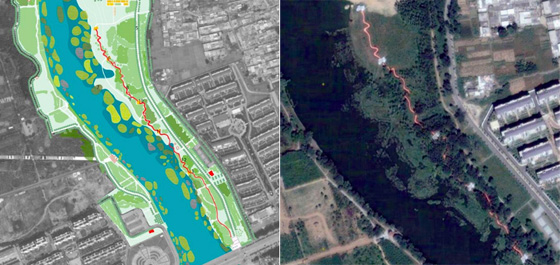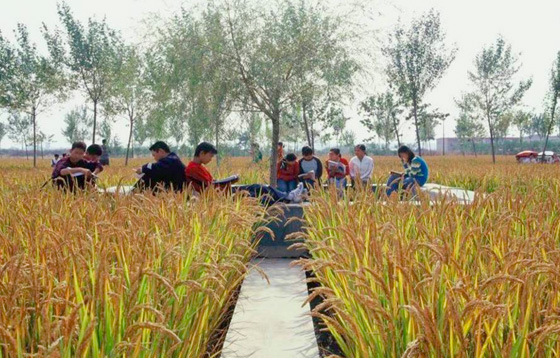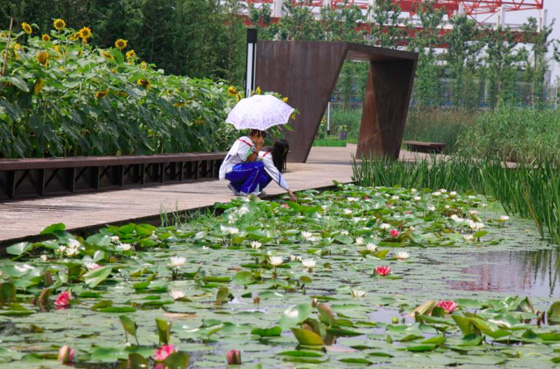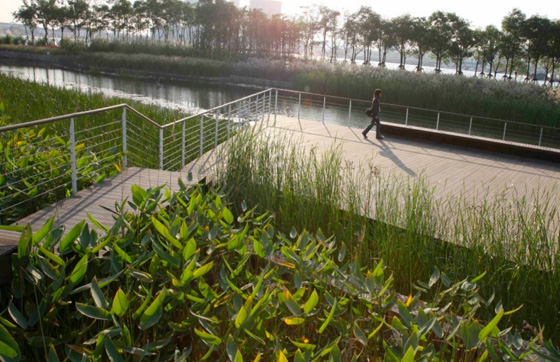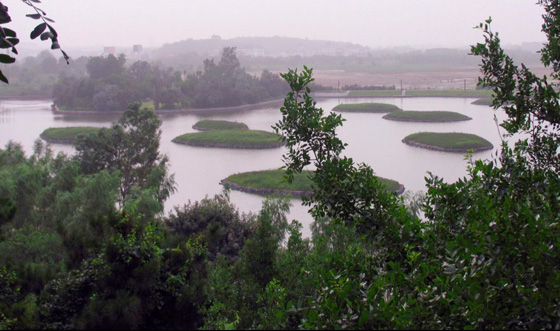48th IFLA World Landscape Architecture Congress 2011
Texte par Susanne Fritz
Suisse
29.06.11
Professor Kongjian Yu, founder of Turenscape Landscape Architects, is one of the world's leading landscape designers. He gave a revolutionary lecture at the IFLA congress in Zurich, entitled 'Reinventing the good earth'.
„Minimize Intervention and maximize Return“ - a rational description of the very poetic project "Red Ribbon Park"

„Minimize Intervention and maximize Return“ - a rational description of the very poetic project "Red Ribbon Park"
×Prof. Kongjian Yu's address to a large audience in Zurich's Kongresshaus began with a retrospective journey through his life. Born in China in the 1960s, he came from a farming background. This influenced his perception of the interconnections between nature and the cultivation of the landscape. He believes that the latter can only produce a good yield if it adapts itself to the conditions imposed by the former – an ecological and economic approach which is the dominant feature of his landscape planning.
Among hundreds of candidates from the whole of China Kongjian Yu was one of 60 students to be given the opportunity of studying garden design – for him an ironic development because his previous dealings with plants had been in terms of earning a living rather than aesthetic pleasure. On a journey through China after completing his studies he perceived the condition of the environment as critical and made the decision to dedicate himself to finding solutions to the problem. He received a grant to study at Harvard University and, armed with his doctorate, this polite and modest man returned to China with an objective which was no less than the 'Big Foot Revolution'.
The metaphor of red ribbon has a decorative feature in that it does not confine nature but serves to highlight its beauty
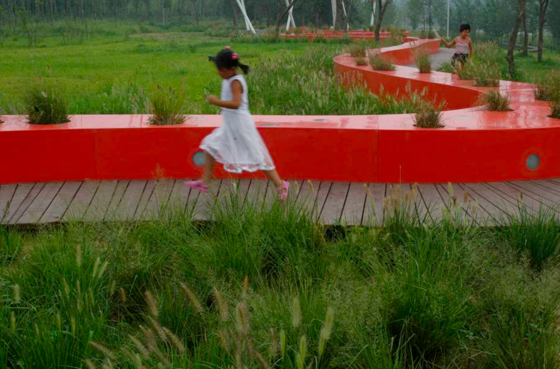
The metaphor of red ribbon has a decorative feature in that it does not confine nature but serves to highlight its beauty
×The illumination of the bench at night is not only romantic but also provides safety to the path
The 'Big Foot Revolution' is a metaphor which is derived from overcoming the oriental custom of deforming women's feet. It is based on the perception that aspects of civilisation which suppress nature represent a waste of resources. In contrast, forms of civilisation which operate in harmony with ecological principles and the sensible application of natural laws are much more productive.
Prof. Kongjian Yu developed simple but revolutionary solutions. By means of 'productive plants' which are native to the region it is possible to landscape large areas and create fields. The 'disorderly' plants, as Yu describes them, don't need to be pruned and watered, and they have a natural beauty. Sunflowers and rice have a symbolic character – and their fruits can be harvested.
Red Ribbon Park project: The kilometre long bench can even be seen from space
Embankments and canals are replaced by parks which provide space for water. Marsh plants such as lotus, reeds and rice provide natural and flexible reinforcement for the shoreline. For the giant dimensions of the Turenscape Landscape Architects projects these 'natural' solutions represent a method of revitalising large, desolate areas within a short space of time.
For the Shenyang Architectural University project Perenscape Architects took advantage of this concept of productive planting and natural water regulation, creating the campus landscape within only six months. The site was declared to be alluvial land, a buffer zone for floodwater, and rice and buckwheat were planted on it. Narrow paths connect the individual buildings on the campus and lead to platforms which provide space in the open air for study, debate and even meditation. Once it has been harvested the rice can be purchased, while goats feed on the plant residues left on the site after the harvest.
Shenyang Architectural University: rice and buckwheat were planted, goats feed on the plant residues left on the site after the harvest

Shenyang Architectural University: rice and buckwheat were planted, goats feed on the plant residues left on the site after the harvest
×In Switzerland, which this year is hosting the IFLA, cows and goats are 'custodians of the landscape', regardless of whether the dairy industry can be managed competitively with free-ranging cattle. They are part of our landscape tradition and maintain the biodiversity of our typical upland pasture and alpine meadows.
In contrast the characteristic traditional feature of the Chinese landscape is the paddy fields which counteract the erosion of the slopes and at the same time have a purifying effect on the water as it trickles downwards. This ancient principle has been applied in Ningbo within an 80-hectare park, with filtration of the water which seeps through the plants enabling 250,000 m³ of clean water to be obtained.
Landscape as a living machine to clean polluted water: Houtan Park of Shanghai Expo
A further metaphor which Prof. Kongjian Yu likes to use is in the red ribbon, which has a decorative feature in that it does not confine nature but serves to highlight its beauty. A ribbon of supernaturally large dimensions runs through the Red Ribbon Park project. The kilometre long bench can even be seen from space. In spite of this the slogan of Perenscape Architects is 'Minimize Intervention and maximize Return'. Measured against the size of the area which has been landscaped the bench represents a real enhancement to the riverbank with minimal intervention, making it accessible to people and turning it into a promenade in the heart of natural surroundings.
Perenscape now advises one third of the mayors of Chinese cities and employs a workforce of over 600. Prof. Kongjian Yu's course in landscape architecture at Peking University has grown from 2 to 200 graduates. Just as fast as the country pursued a course of radical industrialisation without any regard for its cost to the environment, a major rethink now seems to have taken place. Mistakes have been made, but they are (at least in part) also being recognised.
In the course of our conversation with Prof. Kongjian Yu he commented: "The IFLA is the most important congress for landscape architecture," adding with a smile "It's great that it is taking place here in Zurich – even though there's not much for you to do here, everything is already very attractive. The processes may be slow, but no major mistakes are made." Or perhaps they have already been identified and corrected.
The ancient principle of the rice terraces revisited: phytofiltration of the water which seeps through the plants
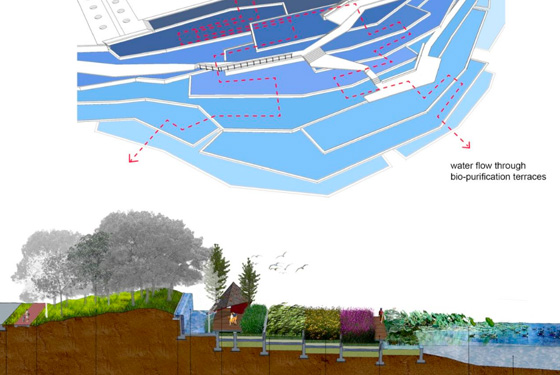
The ancient principle of the rice terraces revisited: phytofiltration of the water which seeps through the plants
×Tianjin Qiaoyuan Park: Ecological recovery of a deserted site for multiple eco-services




